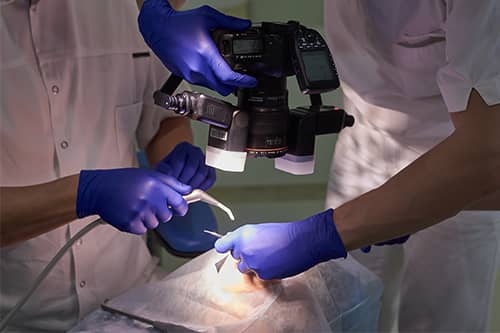
Gum grafting is a dental procedure that aims to restore receding gums, which can result from gum disease and other conditions. It’s essential for the health and appearance of your teeth, and it’s important for patients to understand the different types of gum grafting procedures available.
In this blog, we will explore the basics of gum grafting and review the various techniques. Plus, we’ll provide aftercare instructions and tips for a smooth recovery process.
Why is Gum Grafting Necessary?
Gum grafting is necessary when a patient experiences gum tissue recession due to periodontal disease (advanced gum disease), aggressive tooth brushing, or other factors. This can expose tooth roots, leading to tooth sensitivity, an increased risk of cavities, and an unattractive smile. A gum graft can cover exposed roots, protect teeth from further damage, and improve the appearance of your smile.
Types of Gum Grafting Procedures
There are several gum grafting techniques, but the most common types of gum grafts are connective tissue, allograft (donated tissue), free gingival, and pedicle (lateral) grafts.
Connective Tissue Grafting
Connective tissue grafting is the most common type of gum graft. It involves taking healthy gum tissue from the roof of your mouth (the palate) and placing it over the exposed tooth root(s). After the graft is secured, the palate and surgical site are sutured. This can also be accomplished by using a donated graft (allograft). In this scenario, we do not have to obtain the grafting tissue from the palate, resulting in only one surgical site
Free Gingival Grafting
A free gingival graft is similar to a connective tissue graft, but instead of removing the tissue from the deeper layers of your palate, it’s taken from the top layer. This technique is typically used on patients with naturally thin gums. It is intended to increase the thickness and keratin layer of the gums. It is not intended to cover the recession.
Pedicle (Lateral) Grafting
Lateral grafting is a more advanced technique. It involves taking tissue attached to the side of the existing gums and stretching it over the affected area. This method requires a high level of skill and accuracy but can be very effective when done properly.
Aftercare and Recovery Tips
Regardless of the gum grafting procedure, proper aftercare is crucial for a smooth and successful recovery. Here are some general tips for speeding up the healing process:
- Avoid touching, brushing, or flossing the treated area for the first week or two.
- Use a soft toothbrush and low-abrasive toothpaste.
- Rinse your mouth with an antiseptic mouthwash to help keep the area clean and reduce inflammation.
- In the first 24-48 hours after surgery, use an ice pack or cold compress to reduce swelling.
- Eat soft, cool foods like yogurt, ice cream, smoothies, or pudding. You can incorporate more soft food into your diet, such as eggs, fish, and pasta, as you are able.
Gum grafting is a safe and effective way to restore receding gums and improve oral health. The key is to make sure you understand the different types of gum grafting procedures available, so you can make an informed decision about which one is best for you. With proper aftercare and a commitment to good oral hygiene, you can enjoy the benefits of a beautiful, healthy smile.
Your Gum Grafting Specialist in Highlands Ranch
Dr. Mike Norouzinia is a highly experienced periodontist specializing in gum graft surgery. He is proud to serve patients in Highlands Ranch and the surrounding areas with the highest standard of dental care. If you’re considering a gum grafting procedure, contact our office today to schedule an appointment. We look forward to helping you achieve a healthier, more attractive smile!
If you are searching for a periodontist near me, contact Highlands Ranch Perio at (303) 683-1144 or complete the online booking form. We look forward to helping you with your beautiful smile!
Frequently Asked Questions
In patients who do not have gum disease, the main cause is wear and tear. Along with other causes such as aggressive tooth brushing, genetics, orthodontics, and tooth position.
No, receding gums cannot be reversed, but they can be treated with gum grafting surgery. This procedure will help to restore the tissue and protect the exposed tooth roots.
The best way to stop receding gums from getting worse is to practice good oral hygiene and visit your dentist regularly. Regular cleanings and checkups can help identify gum disease in the early stages when it’s easier to treat. Avoid tobacco use, use a soft-bristled toothbrush, and limit acidic foods and drinks.
Your gums will go through a series of changes as it heals. There are four main stages: rapid hemostasis, inflammation, proliferation, and tissue remodeling. It is normal for your gums to look grey, red, or swollen during the first few weeks of healing. Over time your gums should return to their natural color and texture.
A failed gum graft may look like a pocket of pus or discoloration in the grafted area. Additionally, you may experience pain or discomfort as well as bleeding and swelling. If you notice any of these symptoms after your surgery, it’s important to contact your dentist right away.
